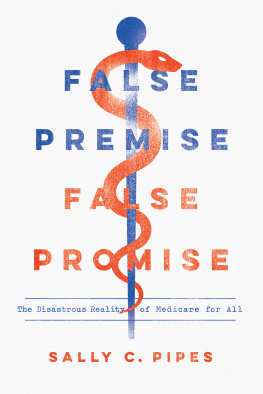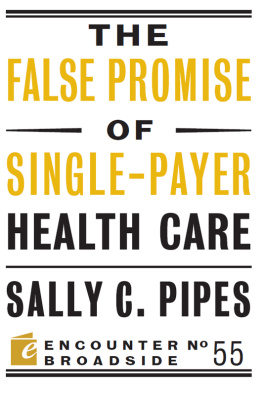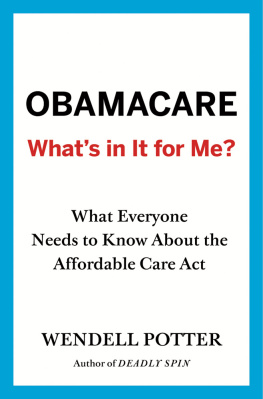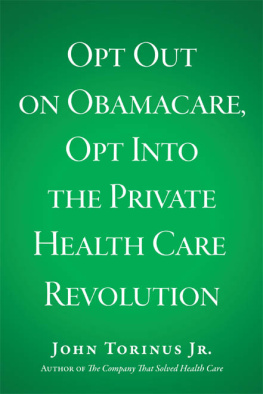H OW K ING V. B URWELL S AVED O BAMACARE A T L EAST T EMPORARILY
T HE FUTURE OF American health care was never less certain than in the days before June 25, 2015.i The U.S. Supreme Court had yet to issue a ruling in King v. Burwell, a potentially fatal challenge to the Patient Protection and Affordable Care Act, President Barack Obamas signature health reform package.
At stake? The future of Obamacares insurance exchanges. A judgment against the administration would have effectively dismantled these marketplaces and the law with them. A verdict in the governments favor would have preserved the status quo and saved Obamacare.
King v. Burwell asked the high court to consider whether the Affordable Care Act allowed the Internal Revenue Service to provide tax credits subsidizing health coverage through the federal governments HealthCare.gov exchange. The laws text explicitly states that credits are available through an Exchange established by the State.ii
The meaning of State was far from academic. Thirty-four states opted not to build their own exchanges and left the task to the federal government.
If the court read State at face value, then millions of Americans shopping in the federally operated exchange would lose the subsidies that made their health insurance affordable. And if millions of customers left HealthCare.gov, the cost of insurance for those remaining would spiral upward. After all, only those who thought theyd have expensive medical bills would keep paying for coverage.
As that process repeated, Obamacares exchanges would collapse. And so would the law.
So in those first few days of the summer of 2015, the nation waited to learn whether the Supreme Court would save Obamacare as it had three summers prior, in June 2012.iii
A Difference of Interpretation
Heres how King v. Burwell ended up before the U.S. Supreme Court.
Four cases challenging the IRSs authority to distribute subsidies through the federal exchange were launched in different parts of the country.
A three-judge panel of the U.S. Court of Appeals for the D.C. Circuit ruled against the government in Halbig v. Burwell in July 2014.iv The U.S. District Court for the Eastern District of Oklahoma also ruled against the federal government in Pruitt v. Burwell in September 2014.v The U.S. District Court for the Southern District of Indiana heard arguments in Indiana v. IRS in October 2014.vi
The U.S. Supreme Court chose to hear the fourth case. A Virginia man named David King, along with three others, hoped to avoid the requirement that he purchase health insurance. With subsidies, his insurance through HealthCare.gov would run $275 a month an amount deemed affordable by the law and thus subjecting him to the laws individual mandate.
Without subsidies, hed face monthly premiums of $648. The Affordable Care Act considered this latter sum unaffordable, so King would be allowed to flout the individual mandate without penalty.vii
In other words, the subsidies would actually make King worse off by forcing him to spend $275 every month that he otherwise would not have spent.
King lost his case before the U.S. Court of Appeals for the Fourth Circuit and appealed to the Supremes.viii
Burwell in the case is Secretary of Health and Human Services Sylvia Mathews Burwell. Since her agency oversaw the implementation of the subsidy rule at the center of the case, she was named the defendant.ix
The plaintiff argued that he shouldnt have had to accept the federal governments largesse. Obamacares text provided subsidies through an Exchange established by the State. A straightforward reading would take State to mean one of the 50. On top of that, the law specifically defines State as each of the 50 States and the District of Columbia.x
King was shopping for coverage in Virginia one of the 34 states that never established its own insurance exchange.xi But the Obama administration gave residents of the Old Dominion tax credits anyway. In doing so, the plaintiff argued, the IRS overstepped its authority and broke the law.xii
For King v. Burwells dissenters, the majoritys decision amounted to a willful misreading of the law.
The administration, by contrast, posited that Obamacares overall structure superseded one inartfully drafted phrase. Without subsidies, the exchanges would crumble. Congress couldnt possibly have meant for four words located deep within section 36B to blow up the entire law.xiii
It followed, the government claimed, that any interpretation of the law prohibiting subsidies for federal-exchange customers was mistaken.xiv
Saved by the Court
The Supreme Court ended up ruling 6-3 against the plaintiffs. Chief Justice John Roberts wrote for the majority: Congress passed the Affordable Care Act to improve health insurance markets, not to destroy them. If at all possible, we must interpret the Act in a way that is consistent with the former, and avoids the latter.xv
Tax credits would continue to flow through the federally operated exchanges. Approximately 5 million people would keep their subsidized coverage.xvi
For the cases dissenters, the majoritys decision amounted to a willful misreading of the law. Writing for the minority, Justice Antonin Scalia expressed his concerns with characteristic bluntness: Words no longer have meaning if an Exchange that is not established by a State is established by the State.xvii
The majoritys somersaults of statutory interpretation, he continued, reveal the discouraging truth that the Supreme Court of the United States favors some laws over others, and is prepared to do whatever it takes to uphold and assist its favorites.xviii
We should start calling the law SCOTUScare, he concluded.
The Supreme Court had rescued Obamacare once again. Chief Justice Roberts had provided the same brand of creative legal reasoning hed found to uphold the individual mandate back in 2012.
He may have believed that Congress did not intend to destroy Americas health insurance market by passing Obamacare. But thats exactly what has happened.













